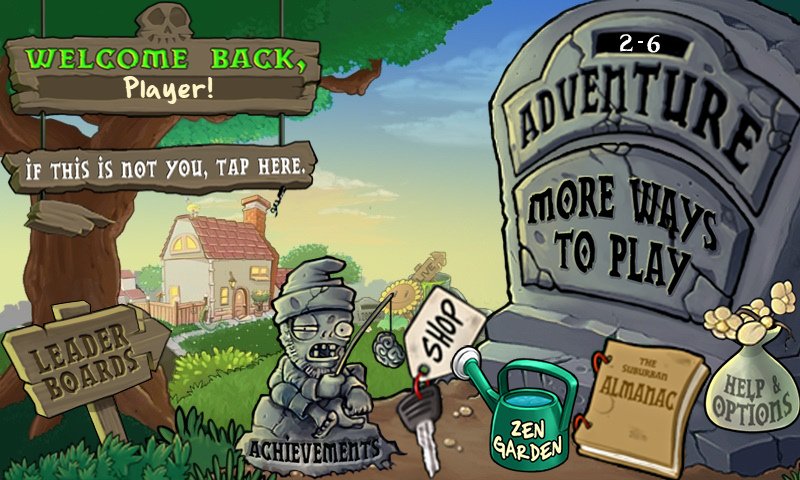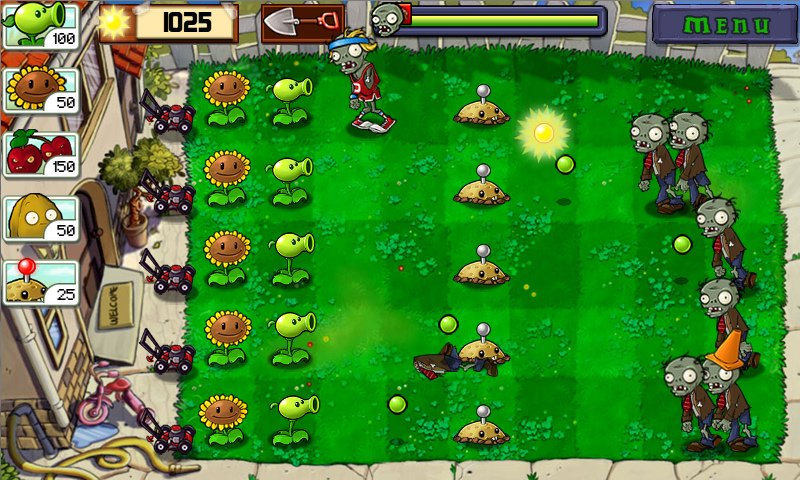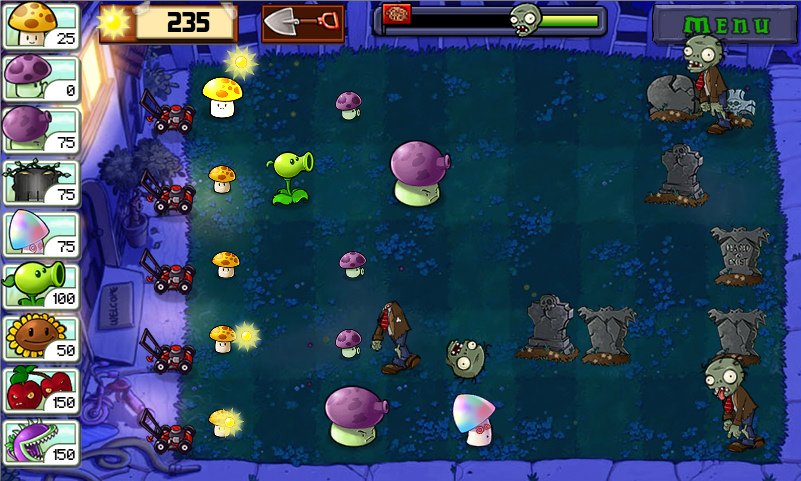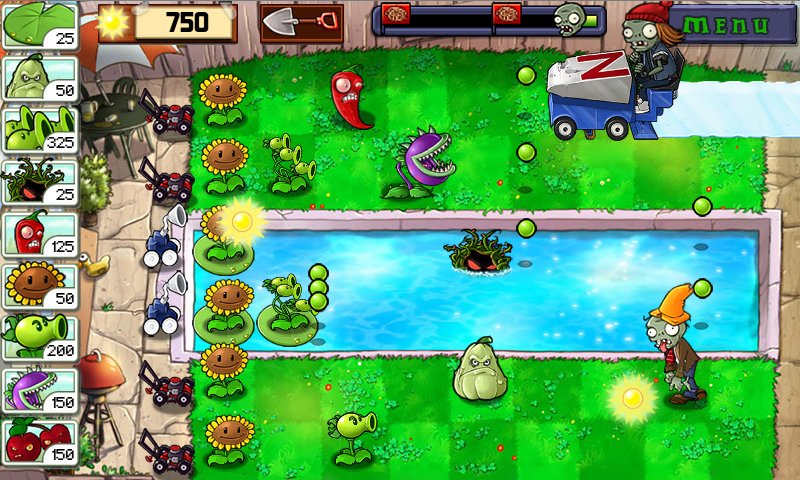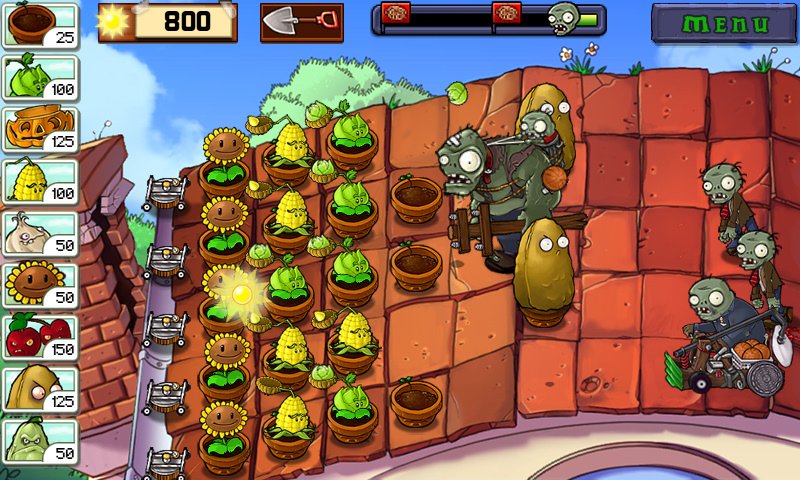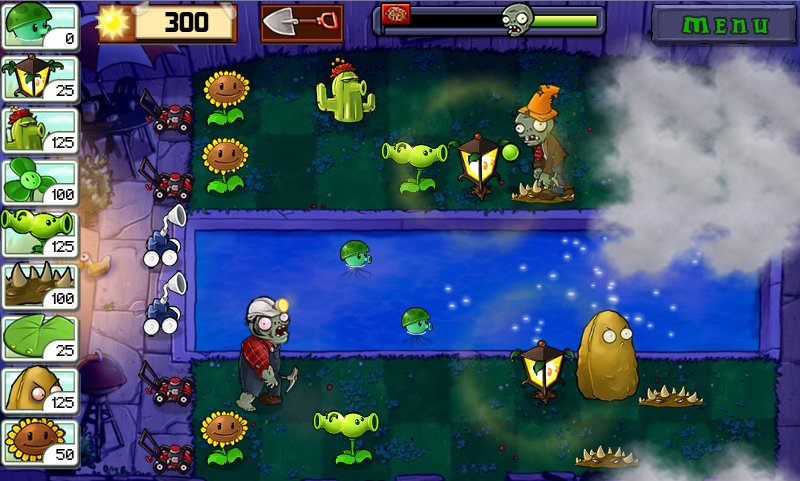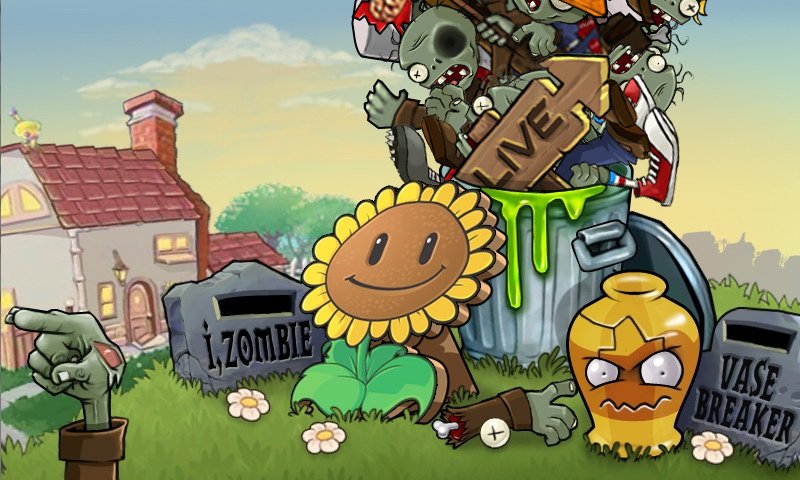Plants vs. Zombies: Xbox Windows Phone Review

As a critic, it’s rare that I can unequivocally say that a game is the very best game in its genre. So many titles do different things well, and they usually have their minuses too. It’s even more uncommon for a game to transcend its own genre and become something that appeals to pretty much everybody. That’s why Plants vs. Zombies is such an amazing game. Not only is it hands-down the best tower defense game on Windows Phone, it also tweaks tower defense conventions and brings so much content that even tower defense naysayers will find a lot to enjoy.
What exactly is tower defense? It’s a type of real-time strategy game. Players build stationary towers which shoot at enemies as they try to reach the player’s base. To put that in Plants vs. Zombies terms, zombies attack the gamer’s yard, striving to get inside the house and eat the tasty brains inside. Weaponized plants with faces and personalities take the place of mechanical towers. In case it wasn’t immediately obvious, this game is loaded with charm and humor.
Watch out for potato mines as you head past the break for our full review.
Tweak tweak!
Silliness, aside, Plants vs. Zombies does several things in the game play department that differentiate it from its peers. First off, the levels in most other tower defense games like geoDefense contain complex, winding pathways for enemies to travel. In PvZ, the path is incredibly simple: zombies approach from the right and travel in a straight line to the player’s base on the left. The field (i.e.yard) is divided into five distinct lanes. Zombies can’t change lanes, nor do most plants affect lanes other than their own. Every 10 levels in the 50-stage Adventure Mode changes the environment slightly, adding a pool to the middle lanes of the yard, taking place at night, or moving the fight to an angled rooftop, but the right-to-left, distinct lane setup never changes.
Succulent sunlight
Resource management also works differently in Plants vs. Zombies. Since the ‘towers’ are plants, they’re naturally fueled by sunlight. This is acquired either from the balls of sunlight that intermittently fall into the yard or by planting sunlight-producing Sunflowers and Sun-shrooms. Balls of solar energy disappear after a few seconds, so players need to actively pick them up (by tapping) throughout the course of each level. This creates an active dynamic lacking in some other strategy titles – you’re always grabbing for sunlight (and eventually, money). Come night-time, sun becomes even more precious since it can only be acquired from power-producing plants.
Fighting flora
Much like the sunlight that fuels them, PvZ’s titular plants march to the beat of a different drum. At the start of Adventure mode, only defenseless but essential Sunflowers and simple Peashooters can be planted. As the game progresses, defensive vegetation like Wallnuts and single-use offensive plants such as Squashes and Jalapeños enter the fray. The game bestows new plants every few levels, serving both to reward players for their progress and to gradually teach them how to use new tools against the zombie hordes. Flora and other unlockables can also be purchased from the offbeat vendor, Crazy Dave.
All told, a staggering 49 different plants make up PvZ’s arsenal. Compare that to other tower defense games that only have five, maybe ten kinds of turrets! Clearly variety is on PvZ’s side. With so many weapons and defenses to choose from, some will become favorites while others rarely see the light of day. Regardless, the sheer volume of strategic options on-hand is incredibly empowering.
All the latest news, reviews, and guides for Windows and Xbox diehards.
Upgrades
Plants vs. Zombies does tower upgrades differently too. Only certain plants can be upgraded - under the proper conditions. First the upgraded plant must be unlocked and assigned to the plants the player wants to bring into a level. Upgrades can only be planted over the type of plant they replace. You never really need these upgrades during Adventure mode; they mostly instill diversity to subsequent play-throughs. Yet upgrades like the Gloom-Shroom, which fires zombie-killing fumes all around it, can make harder levels and mini-games much easier.
Also, zombies!
Where there are plants, there must also be zombies. It’s the natural balance of things. 26 types of zombies threaten to munch players’ brains. Most have unique appearances, while some are just the standard zombie sprite wearing buckets and road cones for armor or carrying screen doors for protection. Others can tunnel under players’ defenses, float over them with balloons, or ice over a lane with a Zombony machine. They’re all surprisingly lovable and you almost feel bad for them as they get their heads shot off. It’s no surprise that licensed action figures, figurines, and plush dolls are available for purchase.
Mini-game bonanza
Everything else aside, mini-games are truly Plants’ most standout feature. Initially they pop up in place of standard Adventure mode levels, keeping things fresh. Later on, the More Ways to Play option on the title screen opens up. A total of 19 mini-games can be unlocked:
Zombotany, Wall-Nut Bowling, Slot Machine, It’s Raining Seeds, Beghouled, Invisi-Ghoul, Seeing Stars, Beghouled Twist, Big Trouble Little Zombie, Portal Combat, Column Like You See ‘Em, Bobsled Bonanza, Zombie Nimble Zombie Quick, Whack a Zombie, Last Stand, Zombotany 2, Wall-Nut Bowling 2, Pogo Party, Dr. Zomboss’s Revenge
In addition to those one-offs, the more challenging I, Zombie and Vase Breaker both have multiple levels, endless versions, and their own leaderboards.
Mini-games range from simple and fun (Wall-Nut Bowling, Whack a Zombie) to inspired (Beghouled, a zombiefied version of PopCap’s own Bejeweled) to hair-pulling (Endless I, Zombie and Vase Breaker). These bite-sized activities make up literally half of the game.
Zen: intergalactic gardener
But wait, there’s more! Before Adventure mode is done, players will unlock a Zen garden of their very own. Here plants purchased from Crazy Dave or randomly found during gameplay can be arranged and tended without the fear of zombie interference that we all live with every day. Crazy Dave sells all sorts of stuff for the Zen garden, including fertilizer and a record player to help the plants grow and extra environments for nocturnal and aquatic vegetation.
Is there a point to gardening besides just messing around? Sure, well-tended plants drop coins and jewels for the player (or the purchasable helper snail) to pick up, and fully-grown, shining plants can be sold for big money. Since garden plants are randomly awarded in other game modes and the shop sells lots of things for the garden, this mode becomes a metagame that ties everything else together... Or you can just ignore it and stick to Adventure and Mini-games.
I fell in love with a girl at the art show
‘Casual’ games often get the short end of the artistic stick, but not so with Plants vs. Zombies. Plants and zombies alike consist of sharp, well-animated sprites. Combined with the colorful backgrounds, PvZ becomes one of the best-looking 2D games on Windows Phone. The only hitch: in rare instances when the screen is chock full of enemies and projectiles, the game slows down just a bit. These minor frame rate drops are infrequent and don’t detract from the experience.
Even the title screen and menus display a creative flair. Just look at the in-game Achievement list: it’s housed within a deep grave. Scrolling down the grave reveals skeletal characters from other PopCap games and eventually… let’s just say the grave is as deep as it gets. The friends Leaderboards area is just as brilliant. Sure, it keeps track of high scores from the Endless I, Zombie and Endless Vase Breaker minigames. But the total number of zombies killed is represented by a huge stack of zombies sticking out of a trash can. The more you kill, the higher the stack gets. Plus, friends’ positions are marked on the stack too. It’s a clever implementation of a feature that most games relegate to afterthought status.
I would be remiss if I forgot to mention Laura Shigihara’s brilliant soundtrack. Suffice it to say that PvZ’s tunes fit the game perfectly and will almost certainly get stuck in your head. The music video that plays during the ending (as a YouTube video in the Windows Phone version) is hilarious and catchy. Oh, and like all PopCap games, the sound effects (and silly voice samples for zombies and Crazy Dave) flawlessly enhance the game play.
Achievements

Plants vs. Zombies’ 18 Achievements will take some time to acquire. It’s a vast game, after all. Several are completely optional challenges, like completing a daytime level with only nighttime plants. The only truly challenging Achievements are for reaching specific waves in Endless Vase Breaker and I, Zombie. Both mini-games will challenge even seasoned PvZ vets like myself, likely requiring several hours of attempts to complete. They never stop being fun though, and you’ll earn plenty of money and garden plants in the attempt. For extra help, check out my friend Yip Yoo's guide over at Xbox360Achievements.org.
Overall Impression
As far as I’m concerned, Plants vs. Zombies is the best game on Windows Phone. Even after completing the PC version inside and out, I still had a blast playing the nearly-identical mobile version on the go. Thanks to the insane amount of things the game gives gamers to do, the replay value is tremendous. Even the Adventure Mode warrants a second play-through as the game pre-select three seeds for each level, mixing up the strategic options and adding a bit of challenge. Whether or not you’re into tower defense games, Plants vs. Zombies is a title that every Windows Phone gamer should experience.
- Plants vs. Zombies - Windows Phone 7 and 8 - 82 MB - $4.99 - Store Link


Paul Acevedo was formerly a Games Editor at Windows Central. A lifelong gamer, he has written about videogames for over 15 years and reviewed over 350 games for our site. Follow him on Twitter @PaulRAcevedo. Don’t hate. Appreciate!
